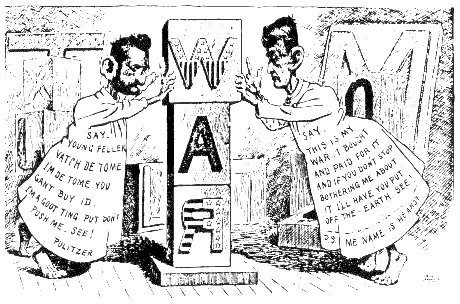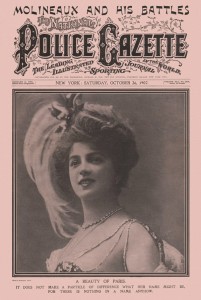Journalists and Historians alike often attribute the rise of sensationalism to the war between Hearst and Pulitzer. For it was during this time in the late19th to early 20th centuries that newspaper editors were looking for ways to sell more papers. The story is classic: the elder Joseph Pulitzer makes something of himself by building the St. Louis Post-Dispatch into the dominant newspaper of that city; all the while William Randolph Hearst looks on as the young buck eager to learn a few lessons that can be applied to his newly acquired San Francisco Examiner. Until finally, both meet in New York where Pulitzer’s New York World and Hearst’s New York Journal go head to head in an all out circulation battle that peaked from 1895-1898.

Courtesy of iml.jou.ufl.edu
Ah yes, the first great sensationalistic newspapers in America, or were they?
In the late 1870’s and early 1880’s an Irish immigrant by the name of Richard Kyle Fox brought his journalistic talents to the United States and began writing for the foundering National Police Gazette, which he took over in lieu of back wages and borrowed heavily to keep afloat. According to Historian Elliot J. Gorn, Fox’s goal was to, ” …make his weekly America’s leading journal of sport, theater, romance, and scandal.” Hardly respectable or rather, newsworthy subjects to be published at that time.

Courtesy of Police Gazette
As Gorn goes on to point out in “A Brief History of American Sports,” “Young women seduced, scantily clad chorus girls, sexual revelations, horrible fires, train wrecks, vicious murders, immoralities of the high and mighty, hangings, and scandals of the stage-these were the stuff of the National Police Gazette. Subsequently, newsstands would not carry the tabloid and many anti-vice societies attempted to shut Fox down completely. Nevertheless, Fox’s publication managed to sell 150,000 copies a week! Quite an impressive feat considering the paper almost folded a couple of years prior.
It was the birth of American sensationalism.Wherever the lower, working-class men gathered to relax, Fox’s publication could be found at the center of the discussion. In defining sensationalism as being controversial, attention grabbing, or unusual, the Gazette hit it right on the head. This paper was targeted at an audience that Fox knew would be willing to pay for the out of the ordinary news. Despite being printed on bright pink pages, having lurid illustrations on it, and being associated with taboo stories, the Gazette received most of its success from sport, in particular boxing.
In the Paddy Ryan-Joe Goss fight in May of 1880, newspapers across the country gave little attention to the fight as the popularity in pugilism had been declining in recent years. Seizing upon this, Fox decided to put out a “fight” edition of the match. This edition focused on providing detailed accounts of the fight from ringside reporters, as well as vivid illustrations by a team of artists, culminating in an edition that, according to Elliot Gorn, “…took readers ringside as no publication ever had.” As a result, the Police Gazette presses ran for weeks cranking out 400,000 fight edition copies to satisfy the demand of sports fans nationwide. Fox continued on after this unprecedented fight to promote sports through his paper and reap the benefits of covering those fights in detail like no other publication could at the time.
In this example of Richard Kyle Fox’s Police Gazette, we see the birth of American sensationalism. Fox rebuilt the dying Gazette upon the foundations of scandal, romance, sex, and sport. By focusing in on sport in particular, Fox managed to sensationalize a particular part of the American population and media. He reported on the unusual and often controversial sport of boxing and capitalized in his success of giving the population those juicy stories it wanted to read. In addition to bringing the first hints of sensationalism to American newspapers, Fox–as Gorn argues and I agree–inspired Hearst and Pulitzer to see the value of sensationalism in selling newspapers.

Leave a response